Expert Voices,
Powerful Transcripts
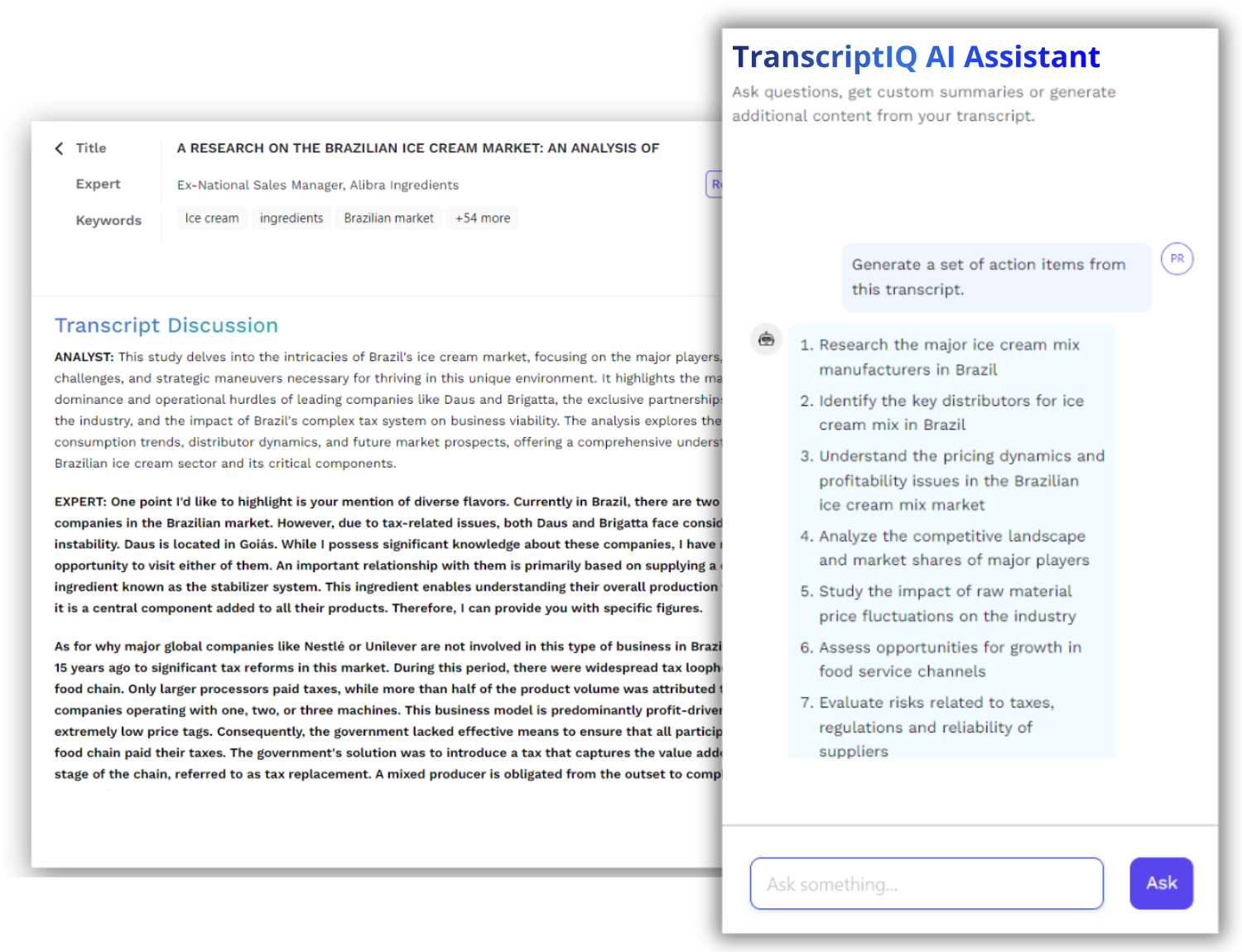





Backed by industry-leading insights and top-tier expert commentary, these transcripts are consistently sought after by decision-makers


Sodium-ion batteries are projected to scale from <10 GWh in 2025 to ~110 GWh by 2030, with China accounting for 70% of this capacity. Initial adoption is led by grid-scale and two-wheeler applications. Rapid pilot-to-commercial transitions in 2026–27 are expected as BYD and HiNa Battery deploy large-scale facilities in Jiangsu and Gujarat. Global market penetration reaches ~12–15% by 2030, reflecting sodium’s cost and availability advantages over lithium.
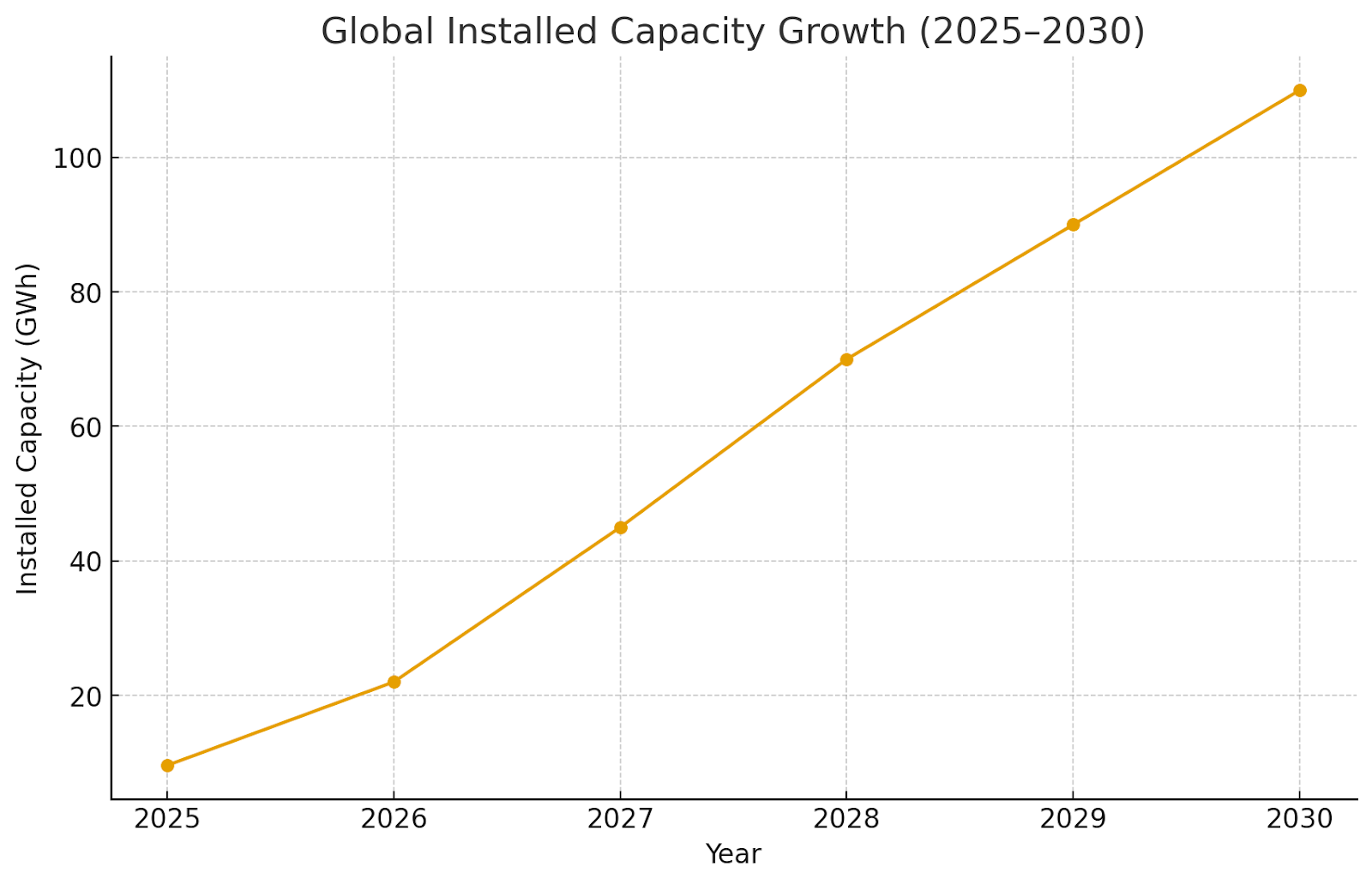
Sodium-ion’s key cost advantage lies in raw materials: sodium carbonate at ~$260/ton vs lithium carbonate at $13,000–18,000/ton. Absence of nickel and cobalt further trims pack costs by 15–18%. Manufacturing CAPEX is comparable, but cell assembly requires lower environmental control, reducing facility costs by ~12%. By 2030, Na-ion packs are expected to cost ~$60/kWh compared to lithium-ion’s ~$115/kWh, driving strong substitution potential in cost-sensitive markets.
Stationary storage (grid and renewables) will represent ~55% of Na-ion demand by 2030, followed by two-wheelers (25%) and light EVs (15%). Consumer electronics remain a minor use case (<5%). Unlike lithium-ion, Na-ion’s moderate energy density (~160 Wh/kg by 2030) restricts long-range EVs but aligns with daily commuter and distributed storage markets. OEMs in India and Southeast Asia are early adopters due to favorable climate compatibility.
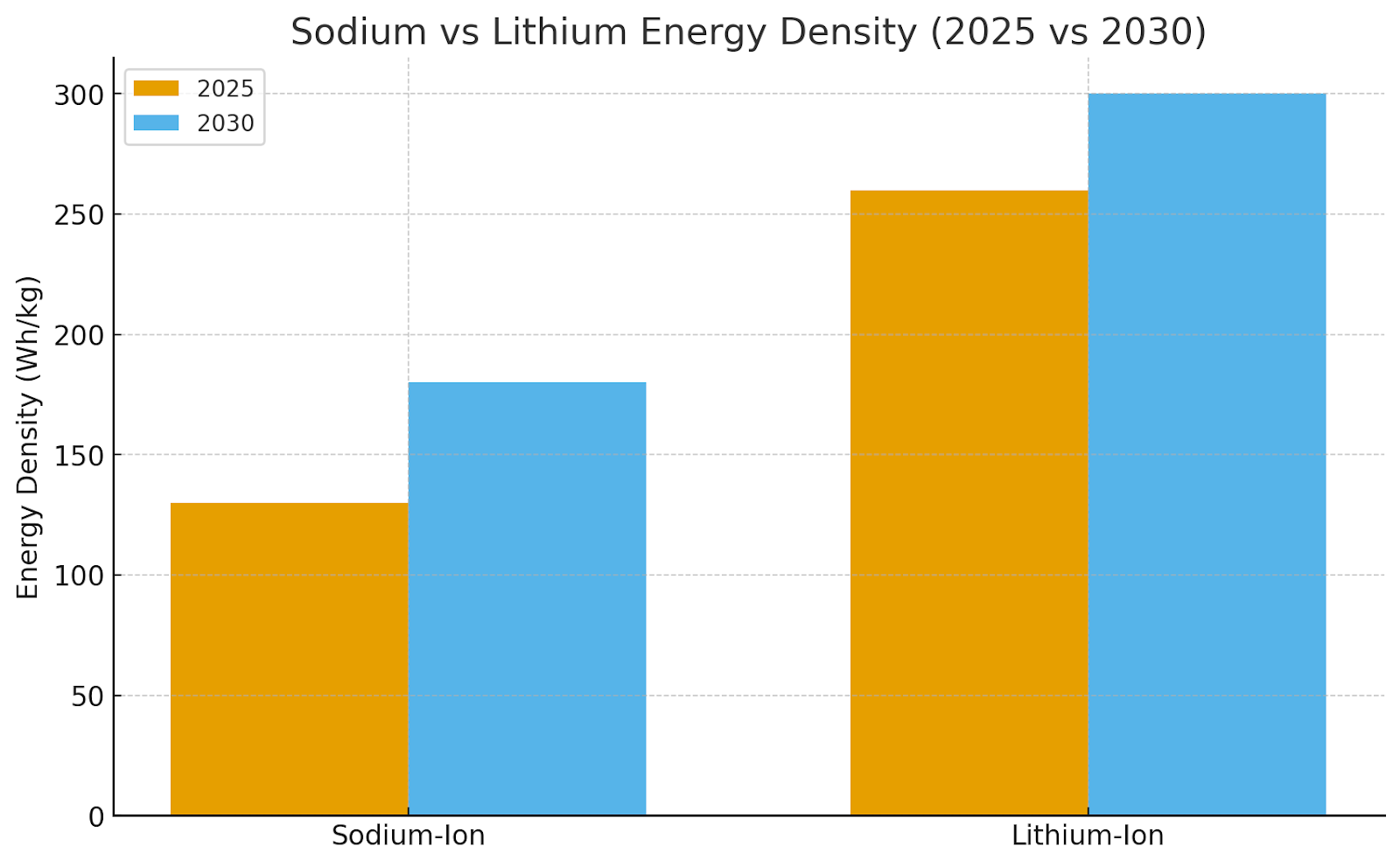
Current sodium-ion limitations include lower energy density (160–180 Wh/kg vs 250–300 Wh/kg for Li-ion) and suboptimal cycle life (~2,000 cycles). R&D efforts by Faradion and Tiamat Energy target density gains via hard carbon anodes and Prussian white cathodes. Thermal stability is an advantage, reducing fire risk by 25–30%. Key engineering focus through 2027 remains electrolyte optimization and mass-production standardization.
CATL leads commercialization with Na-ion battery packs integrated into Chery and Sehol EVs. Faradion (India/UK) and HiNa Battery (China) are major cell developers, while Northvolt and BYD plan hybrid Na-Li product lines by 2027. Patent filings for Na-ion tech rose 4.5x from 2021–2024. Supply chain verticalization — especially in China — provides a 20% cost edge. Europe trails with pilot-scale production under Tiamat and Altris initiatives.
Unlike lithium, sodium resources are geographically ubiquitous — primarily derived from seawater and soda ash. Raw sodium feedstock prices are 99% less volatile than lithium, ensuring predictable supply chains. Sodium carbonate capacity (~80 Mt globally) easily meets 2030 battery-grade demand of 5.5 Mt. The absence of cobalt and nickel cuts ESG risk and reduces mining dependency. China, India, and the U.S. collectively control >60% of sodium refining capacity.
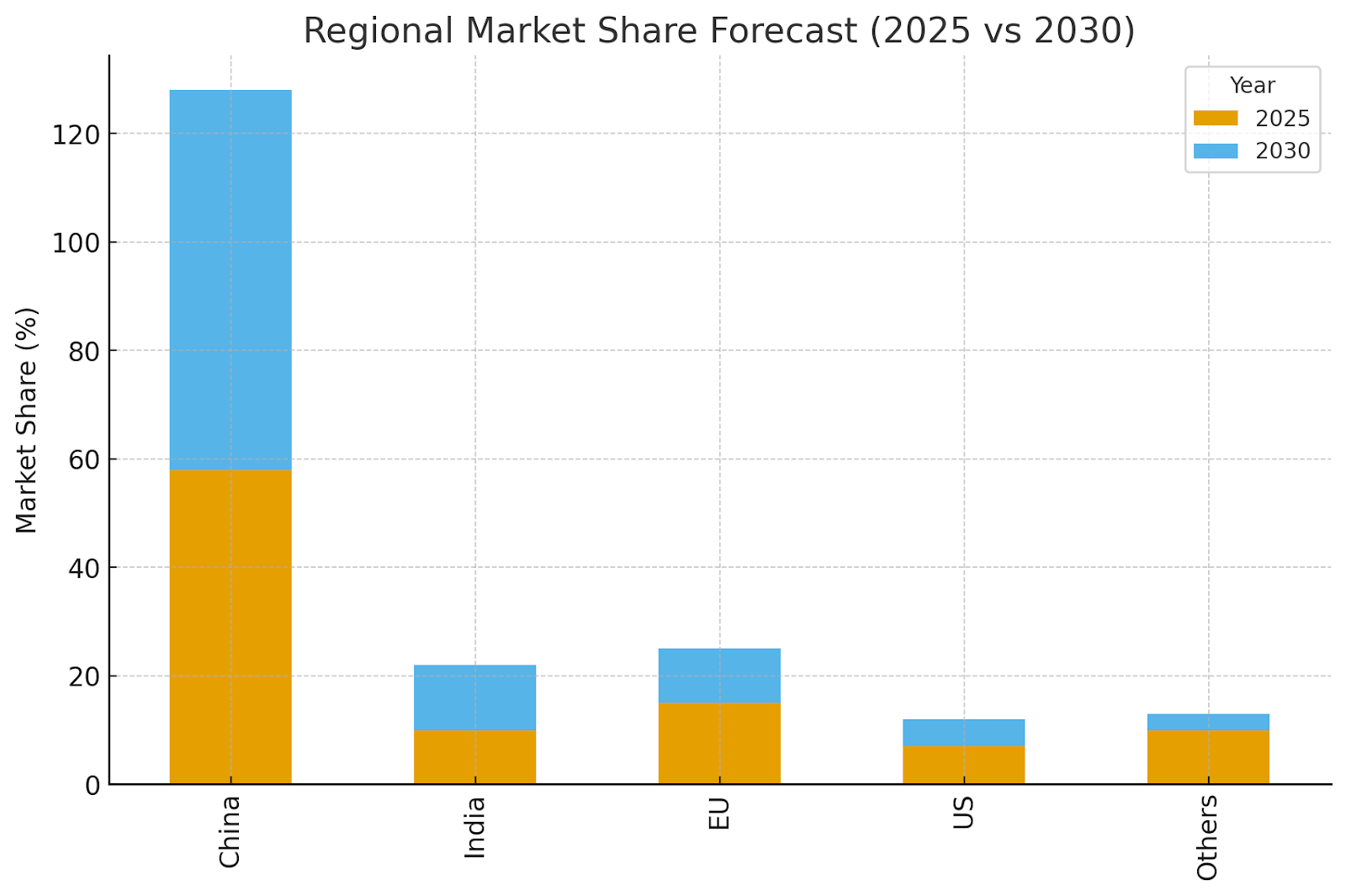
China dominates Na-ion battery manufacturing with over 70% capacity by 2027, led by CATL and HiNa. India and the EU emerge as secondary hubs; Reliance and Tata Chemicals target 6–8 GWh combined capacity by 2030. Europe’s focus is stationary storage; India’s is two-wheelers. U.S. adoption lags due to policy gaps but could accelerate post-2028 with DOE-backed pilot programs.
OEMs are leveraging Na-ion packs to reduce dependence on lithium volatility and cut pack cost-to-sales ratio from 22% to 16% by 2030. BYD’s hybrid LFP–Na-ion platforms optimize cell integration, while Tata Motors plans sodium-based EVs under $10,000. Suppliers are co-locating cathode and pack assembly plants to minimize logistics and tariffs, saving ~$7–8/kWh. Enhanced thermal tolerance reduces need for expensive BMS systems.
Despite cost advantages, challenges include low energy density and limited charging infrastructure compatibility. Investment risks stem from uncertain automotive demand and lack of global standards. If energy density improvements stall below 170 Wh/kg, mass EV adoption could be delayed by 2–3 years. Dependence on Chinese supply chains also poses geopolitical risks. Analysts expect cost parity with LFP only by 2028 if large-scale localization occurs.

By 2030, Na-ion is projected to reach 180 Wh/kg energy density and 2,500 cycle life, narrowing the performance gap with LFP. Hybrid chemistries (Na–Li blends) may enter market by 2027, enabling flexible manufacturing lines. Global capacity expansion to 110 GWh reflects strong investment from CATL, BYD, Reliance, and Northvolt.


The global business travel market is forecast to grow from $1.3T in 2025 to $2.4T by 2030, with a CAGR of 12.5%. The shift toward digital travel platforms is expected to dominate 70% of corporate bookings by 2030, as companies adopt AI-powered travel management and predictive analytics to optimize spending. Sustainability will be a key trend, with carbon offset policies driving a 25% reduction in CO₂ emissions from corporate travel. By 2030, 45% of corporate travel spending will go toward sustainable travel practices, including green accommodations and eco-friendly transport options. As Millennials and Gen Z become more prominent in the workforce, the demand for digital-first travel services will increase, making up 30% of all travel services. Additionally, the remote work trend will lead to a 10% reduction in overall travel volume, but it will increase the demand for flexible, technology-driven solutions.
The post-pandemic recovery in the global business travel sector is being led by digital transformation, which allows companies to manage travel bookings more efficiently while reducing CO₂ emissions. AI-powered travel management systems are streamlining processes and increasing booking efficiency by 35%. Corporate travel managers are turning to digital platforms that integrate AI and predictive analytics to better manage travel expenses, optimize routes, and track carbon emissions. By 2030, AI will play a pivotal role in streamlining operations and driving the shift towards sustainable travel. Remote work trends are reshaping corporate travel, leading to an increase in virtual meetings and a 10% decrease in overall travel volume. However, sustainable business travel is on the rise, with 45% of corporate travel budgets allocated to green travel initiatives, as companies aim to meet environmental goals and align with ESG targets.
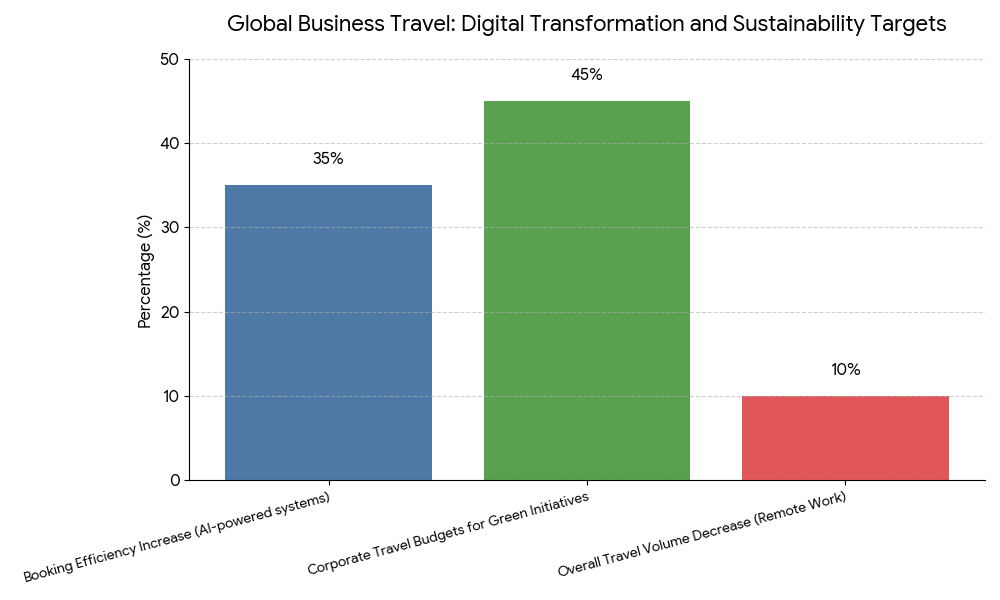
These insights reflect the rapid transformation in global business travel, powered by AI, sustainability goals, and digital-first travel management systems.
The business travel market is segmented into AI-powered travel management systems (40%), sustainable travel solutions (30%), digital platforms (20%), and corporate travel technology investments (10%). AI-powered travel management systems dominate the market, accounting for 40% of investments. These systems enhance booking efficiency, cost optimization, and real-time travel tracking. Sustainable travel solutions, including carbon offset policies and green transport options, are expected to account for 30% of corporate travel budgets. Digital platforms, responsible for 20% of bookings, are driving the shift towards paperless and flexible travel solutions. Finally, corporate investment in travel technologies will see a $5B+ growth by 2030, accelerating the adoption of AI and green travel strategies in business travel management.
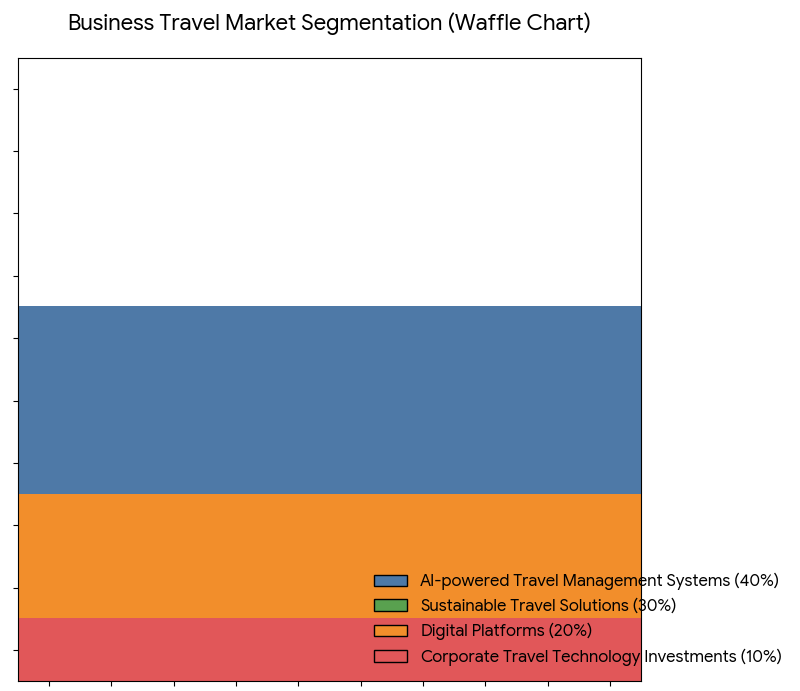
The USA is the largest market for business travel, accounting for 40% of global business travel spending. North American companies are leading the charge in adopting AI-powered travel management systems and sustainable travel practices, driven by the Green Deal and corporate ESG goals. Europe follows closely with 30% of the market, particularly in countries like Germany, France, and the UK, where carbon offset travel and green mobility solutions are increasingly in demand. The Asia Pacific region, especially China and India, is growing rapidly as business travel increases in line with economic recovery. By 2030, North America and Europe will drive 70% of all corporate travel bookings, with digitally integrated solutions and sustainability at the forefront.
Leading players in the business travel management sector include Amadeus, Sabre Corporation, SAP Concur, and Expedia Group. These companies dominate the corporate travel management software market, offering AI-powered platforms for real-time bookings and travel optimization. SAP Concur is a leader in expense management, integrating travel booking with corporate policies. Expedia Group and Booking Holdings are key players in corporate travel services, focusing on digital platforms for flexible and cost-efficient travel solutions. Private companies, such as TravelPerk, TripActions, and Lumo, are leveraging technology and AI to create seamless travel experiences for corporate clients. The market is witnessing increasing competition as start-ups enter with innovative MaaS solutions and green travel initiatives, driving sustainability in business travel.
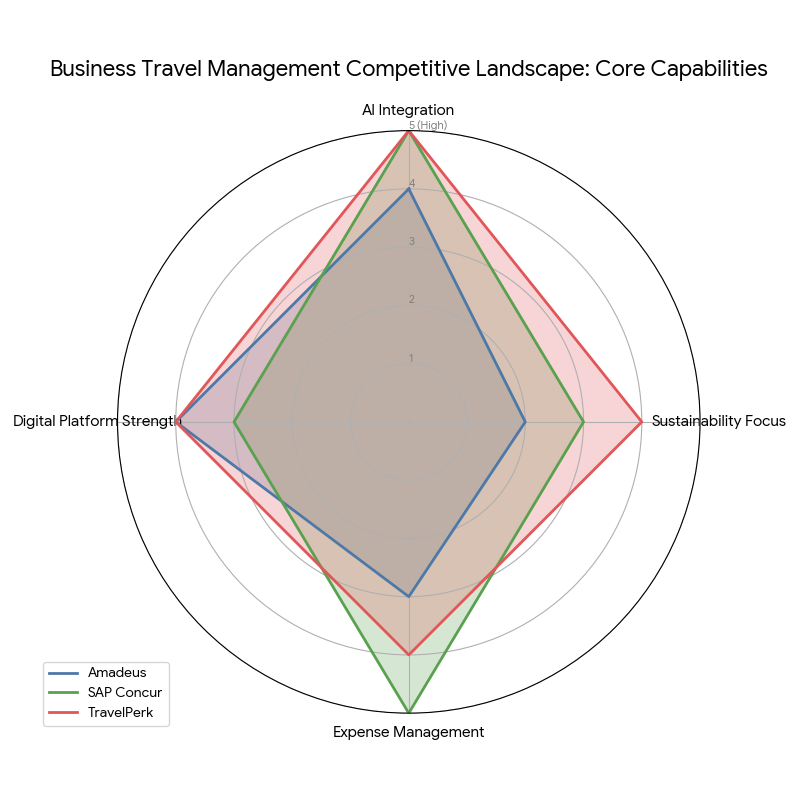


Key Metrics
The global travel fintech market is projected to grow from $15 billion in 2025 to $45 billion by 2030, representing a CAGR of 24%, driven by the adoption of digital payment solutions, blockchain-based payments, and cryptocurrency integration. Digital wallets and mobile payment platforms will dominate, accounting for 55% of travel-related payments by 2030, while cryptocurrency payments will represent 15% of total transactions, particularly in high-value cross-border bookings. Transaction processing costs are expected to decrease by 30%, improving profitability for travel platforms, banks, and fintechs. Travel remittances using crypto are projected to grow 35% annually, providing fast, cost-effective solutions for global travelers. Consumer adoption is expected to increase 50%, as travelers embrace the convenience and security of digital and crypto-based payments. Fraud detection efficiency in travel payments will improve 40% with blockchain, AI, and machine learning technologies. Regulatory compliance for crypto travel payments is projected to reach 75% globally, mitigating risk for both travelers and institutions. Revenue from cross-border travel transactions is expected to grow 45%, driven by seamless international payment processing. ROI for fintech innovations in travel is expected at 18–22%, driven by enhanced efficiency, reduced transaction costs, and higher customer adoption, positioning digital payment technologies as key drivers of growth in the global travel sector.
.png)
The global fintech innovations market in travel is projected to expand from $15 billion in 2025 to $45 billion by 2030, CAGR 24%, driven by the increasing adoption of digital wallets, mobile payments, and cryptocurrency solutions. By 2030, digital wallets and mobile payments will constitute 55% of travel transactions, providing fast, secure, and scalable payment methods. Cryptocurrency adoption will grow to 15% of total travel payments, particularly in cross-border remittances and high-value transactions. The adoption of fintech solutions is expected to reduce transaction costs by 30%, while cross-border payment volumes will increase by 45%, reflecting globalization of travel services. Consumer adoption is projected to increase by 50%, driven by convenience, faster processing, and secure blockchain-based transactions. Fraud detection efficiency will improve 40%, as AI and machine learning tools monitor payments in real time. Regulatory compliance for cryptocurrency travel payments is projected to reach 75% globally, ensuring alignment with regional frameworks. ROI for fintech innovations is estimated at 18–22%, driven by improved efficiency, reduced operational costs, and increased transaction volumes. Travel platforms, banks, and fintechs will leverage these solutions to enhance user experience, increase transaction security, and drive market growth, positioning digital payments as central to the future of global travel finance.
The global travel fintech market is projected to grow from $15 billion in 2025 to $45 billion by 2030, CAGR 24%, driven by the adoption of digital wallets, mobile payments, and cryptocurrencies. Crypto payments will constitute 15% of total travel transactions, primarily for cross-border bookings, offering speed and privacy. Digital wallets and mobile payment platforms will account for 55% of payments, enabling fast, seamless, and cost-efficient transactions. Transaction costs will decrease by 30%, benefiting both travel platforms and consumers. Travel remittances using crypto are projected to grow 35% annually, highlighting increased global adoption. Fraud detection efficiency will improve 40% with AI and blockchain solutions monitoring transactions in real time. Customer adoption rates for fintech solutions will rise 50%, driven by convenience, reduced friction, and enhanced security. Regulatory compliance for crypto-enabled travel payments is expected to reach 75% globally, ensuring secure operations. Revenue from cross-border transactions is projected to grow 45%, as fintech platforms expand global reach. The projected ROI for adopting fintech innovations in travel payments is 18–22%, driven by operational efficiency, cost reductions, and higher adoption. Overall, fintech adoption is transforming travel payments, enhancing security, efficiency, and global market accessibility.
.png)
The global travel fintech market is segmented by payment method (digital wallets, mobile payments, cryptocurrency), geography, and institution type. By 2030, digital wallets and mobile payments will represent 55% of total travel payments, valued at $24.75 billion, while cryptocurrency payments will account for 15%, approximately $6.75 billion. Cross-border remittances will increase by 35% annually, as travelers seek faster, lower-cost solutions. Transaction fraud detection efficiency will improve 40% due to AI and blockchain monitoring. Regulatory compliance is expected to reach 75% globally, ensuring secure and legal adoption of cryptocurrency payments. Consumer adoption of digital payments will grow 50%, driven by convenience and speed. Cross-border payment revenue is projected to grow 45%, as fintech innovations reduce costs and enhance transaction transparency. Financial institutions, travel platforms, and fintechs will drive 65% of adoption, using solutions to improve operational efficiency and customer experience. ROI for investing in travel fintech solutions is expected at 18–22%, driven by reduced costs, improved transaction security, and higher adoption rates. The travel fintech sector is rapidly evolving, with digital and cryptocurrency solutions poised to dominate global travel payments by 2030.
The global travel fintech market covers North America, Europe, Asia-Pacific, and Latin America. Adoption is projected to increase from $15 billion in 2025 to $45 billion by 2030, CAGR 24%, driven by digital wallets, mobile payments, and crypto solutions. Digital payments will account for 55% of transactions, while crypto payments will capture 15%, particularly in cross-border bookings. Transaction costs will decrease 30%, while fraud detection efficiency improves 40%. Cross-border travel transaction volumes will grow 45%, supported by blockchain security protocols. Consumer adoption will increase 50%, and regulatory compliance for cryptocurrency travel payments is projected to reach 75%, ensuring alignment with regional laws. Revenue from cross-border travel payments will expand due to faster processing and lower operational costs. ROI from fintech innovations is projected at 18–22%, driven by increased adoption, cost efficiency, and enhanced security. The US and Europe will remain key markets, but Asia-Pacific and LATAM will see rapid growth, driven by mobile-first adoption and cryptocurrency integration. Fintech innovations will globally standardize secure, fast, and cost-efficient travel payments, transforming the industry.
.png)
The global travel fintech market is highly competitive, with key players such as PayPal, Stripe, Revolut, and Travala driving innovation in digital wallets, mobile payments, and cryptocurrency adoption. Financial institutions and travel platforms will contribute 65% of adoption, leveraging these technologies for cross-border payments, fraud prevention, and enhanced customer experience. Transaction processing costs will decrease by 30%, while fraud detection efficiency improves 40% with blockchain and AI integration. Cross-border travel payments are projected to increase 45%, while consumer adoption grows 50% globally. Regulatory compliance adoption is projected at 75%, ensuring secure operations. ROI is expected at 18–22%, driven by efficiency, security, and reduced operational costs. Competitive differentiation will be achieved through faster transaction speeds, crypto adoption, and user-friendly mobile platforms. Partnerships between fintechs, travel platforms, and financial institutions will expand market reach, accelerate technology adoption, and enhance trust in digital payments, positioning fintech innovations as central to the future of global travel payments.


The AI-powered demand forecasting market in Indian retail logistics is set to expand from ₹2,000 crore in 2025 to ₹11,500 crore by 2030, reflecting a CAGR of 42%. This growth is driven by the integration of AI and machine learning (ML) algorithms that enhance demand prediction, reduce stockouts, and improve warehouse operations. Forecasting accuracy is projected to increase from 75% to 95% by 2030, thanks to the ability of AI models to analyze large datasets and detect consumer behavior patterns in real-time. As a result, stockouts will decline 30%, and inventory holding costs will be reduced by 25% through AI-driven inventory management and order fulfillment optimization. Order fulfillment time will shorten by 22% as AI systems predict demand surges and allocate resources accordingly. Supply chain efficiency improvements from AI adoption will reach 40% by 2030, with logistics providers gaining the ability to better allocate resources, streamline transportation, and improve delivery timelines. By 2030, 60% of Indian e-commerce platforms will integrate AI-powered demand forecasting, leading to smarter inventory allocation and faster delivery. The ROI from AI demand forecasting is projected to be between 18–22%, driven by operational efficiencies, better customer satisfaction, and reduced wastage in retail supply chains.
.png)
The AI-powered demand forecasting market in India and Asia Pacific is set to grow from ₹2,000 crore in 2025 to ₹11,500 crore by 2030, driven by the need for more efficient supply chain logistics in retail and e-commerce. Key trends include the rapid adoption of machine learning algorithms that predict consumer demand with high accuracy. Forecasting accuracy is expected to rise from 75% to 95% by 2030, reducing errors in product allocation and improving inventory management. Stockouts are projected to decrease by 30%, improving sales and customer satisfaction. Order fulfillment time will shorten by 22% due to better demand predictions that optimize warehousing and shipping processes. With AI, inventory holding costs are expected to decline 25%, and supply chain efficiency will increase by 40% as logistics networks become more adaptable and responsive. E-commerce platforms in India will adopt AI-driven forecasting at a rapid pace, with 60% of platforms integrating demand forecasting systems by 2030. The regulatory landscape is expected to be more aligned with AI technologies, with 85% compliance by 2030. ROI for logistics providers implementing AI-powered solutions is projected to be 18–22% by 2030, driven by cost savings, improved speed, and better customer satisfaction.
The AI-powered demand forecasting market in India and Asia Pacific is growing rapidly, projected to reach ₹11,500 crore by 2030 at a CAGR of 42%. Emerging trends in AI and machine learning will significantly improve forecasting accuracy, from 75% in 2025 to 95% by 2030. AI platforms will enhance consumer behavior prediction, with accuracy improving 35% by 2030. The focus on inventory optimization and order fulfillment will lead to 25% savings in inventory holding costs, while stockouts will be reduced by 30%. Order fulfillment time will improve by 22%, driven by better demand modeling and faster response times across the logistics network. By 2030, AI adoption in e-commerce will increase to 60%, allowing retailers to better forecast demand and optimize inventory distribution. With AI, supply chain efficiency is expected to improve by 40%, driven by real-time demand prediction and automated adjustments. As AI and data analytics revolutionize the retail logistics landscape, the ROI for implementing these technologies is expected to be 18–22% by 2030. The regulatory environment is expected to become more AI-friendly, with 85% compliance by 2030, ensuring smoother integration into global logistics networks.
.png)
The AI-powered demand forecasting market in India and Asia Pacific is segmented by logistics type (retail, e-commerce, wholesale), AI platform integration, and market adoption rates. The retail segment is expected to capture 50% of the market by 2030, followed by e-commerce (30%) and wholesale distribution (20%). By 2030, 60% of Indian e-commerce platforms will have integrated AI-driven demand forecasting tools, which will increase order fulfillment speed by 22% and reduce stockouts by 30%. Forecasting accuracy will rise from 75% to 95% as more retailers adopt machine learning and predictive analytics for inventory and consumer demand forecasting. In terms of AI platform adoption, integrated solutions (combining AI, IoT, and predictive models) will dominate 40% of the market, followed by standalone AI systems for smaller players. Cost per unit of forecasted demand will decrease 15%, driven by more accurate predictions and better resource allocation. Supply chain efficiency will improve 40% as AI allows logistics providers to optimize transportation and warehouse operations. ROI for AI adoption in logistics will range from 18–22% by 2030, based on improved accuracy, reduced operational costs, and faster order fulfillment.
The AI-powered demand forecasting market in India and Asia Pacific is projected to reach ₹11,500 crore by 2030, with India leading adoption in the region. Indian retail and e-commerce are expected to account for 60% of the market by 2030, driven by AI-powered logistics platforms that optimize inventory allocation and reduce supply chain inefficiencies. Forecasting accuracy will increase from 75% to 95% by 2030, improving product availability and customer satisfaction. Cross-border supply chain integration will be a key enabler, as AI models increasingly support global demand forecasting for Indian manufacturers. Regulatory alignment will reach 85% compliance by 2030, making AI integration easier across EU–India logistics networks. Cost per patient for forecast-based interventions will decline 15%, and stockout frequency will drop 30%, as predictive modeling becomes more accurate. E-commerce adoption of AI tools is expected to rise to 60% by 2030, improving inventory turnover and reducing reliance on traditional supply chains. Overall, AI-powered forecasting will help India and Asia Pacific leapfrog into more efficient, cost-effective logistics solutions by 2030.
.png)
The AI-powered demand forecasting market in India and Asia Pacific is becoming competitive, with global players such as SAP, IBM, Oracle, and Microsoft entering the retail logistics sector. Local AI vendors like Tata Consultancy Services (TCS) and Wipro are collaborating with Indian retail giants to offer AI-based demand forecasting tools, which enhance inventory management and reduce stockouts by 30%. Emerging companies offering predictive analytics are also gaining traction in small-to-medium enterprises (SMEs). By 2030, e-commerce giants like Flipkart and Amazon India are expected to integrate AI-driven platforms, gaining market share through optimized order fulfillment and inventory turnover. AI-driven solutions will streamline last-mile delivery, and warehousing for Indian logistics providers, improving supply chain efficiency by 40%. ROI for AI-powered demand forecasting solutions is projected at 18–22% by 2030, driven by improved resource allocation, reduced operational costs, and higher customer satisfaction. Firms that successfully combine real-time data from consumers, historical demand, and external factors will lead the competitive landscape, making AI-powered demand forecasting the backbone of India’s retail logistics transformation.

Classic syndicated market research is indispensable for broad strokes—market sizes, historical trends, competitor counts. But in turbulent markets, those PDFs age fast, and surface‑level stats rarely answer the why.
TranscriptIQ flips the model. We capture live operator perspectives through on‑demand expert conversations, then layer the rigor you expect from premium reports—KPIs, segmentation, competitive maps, and forecast signals—directly onto the transcript.
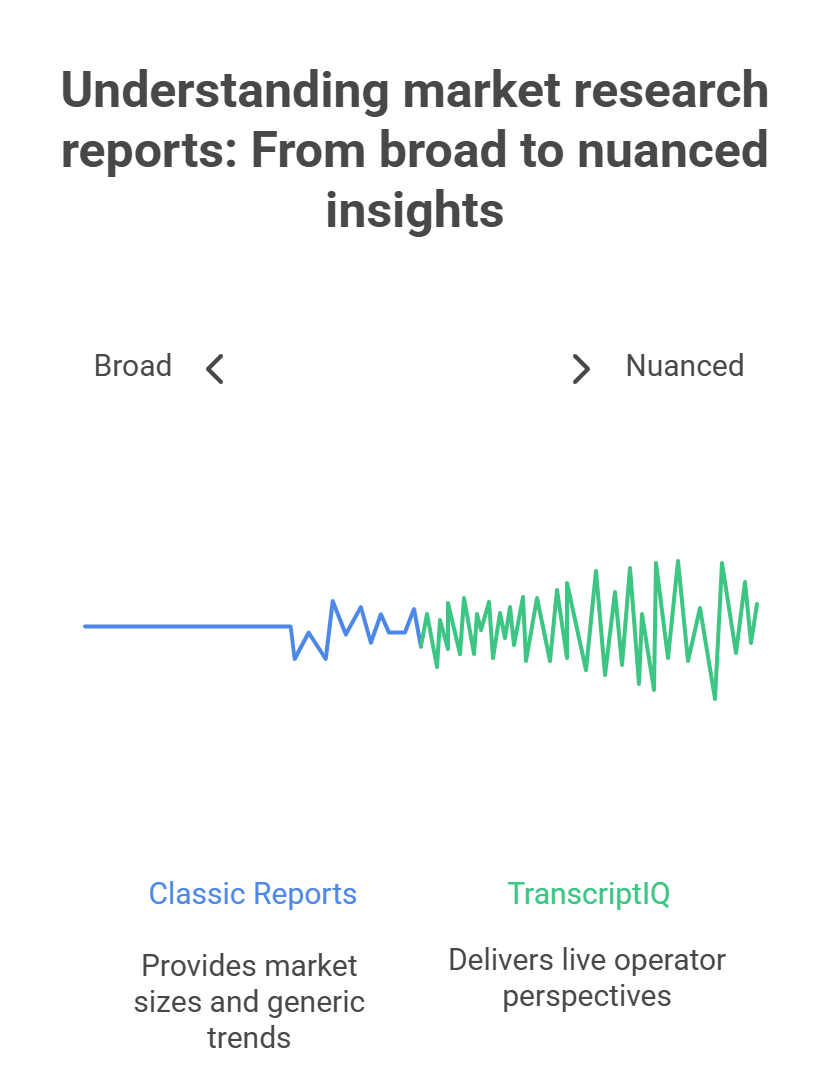






Each transcript includes a verbatim conversation between a domain expert and a professional moderator. It is cleaned, anonymized (if required), and structured with thematic headers, and segmented insights for easy navigation.
Transcripts are generated using a combination of AI-driven speech recognition and human editorial oversight. This hybrid approach ensures clarity, accuracy, and contextual relevance — maintaining technical precision.
Yes, all transcripts are derived from real conversations conducted during primary research engagements with experts across industries and regions. However, confidential company specific information is never disclosed.
Each transcript is tagged by title, keywords, industry, sub-industry & geography. Users also get access to a proprietary AI integrated tool that helps users search within transcripts and answer questions on the transcript, through a simple chat functionality.
Our transcripts feature senior professionals, decision-makers, and niche domain experts with firsthand experience in the topics discussed. These include former CXOs, operators, consultants, and subject matter experts across global markets — all carefully vetted by our in-house research team prior to the interview.
Yes. We offer on-demand transcript packs based on specific themes, companies, or sectors. You can submit a request, and we will curate and share relevant content within 24–48 hours.
Unlike one-off expert calls or static reports that take hours to comprehend, transcripts provide scalable, reusable insights at speed — with structured data that allows for trend spotting, comparative analysis, and thematic exploration.
Absolutely. All expert conversations are conducted within compliance frameworks (e.g., no MNPI, insider trading, etc.), and any sensitive expert or sensitive company information identifiers are removed before transcripts are published. In fact, our moderators are trained to ensure such information is never discussed over an expert conversation.
Our unique pay-per-transcript model, is a first of its kind offering. Additionally, we also offer flexible access models, including monthly subscriptions and enterprise packages for larger organizations.
The database is updated weekly, with new transcripts added from ongoing expert interviews conducted by our seasoned team of moderators.